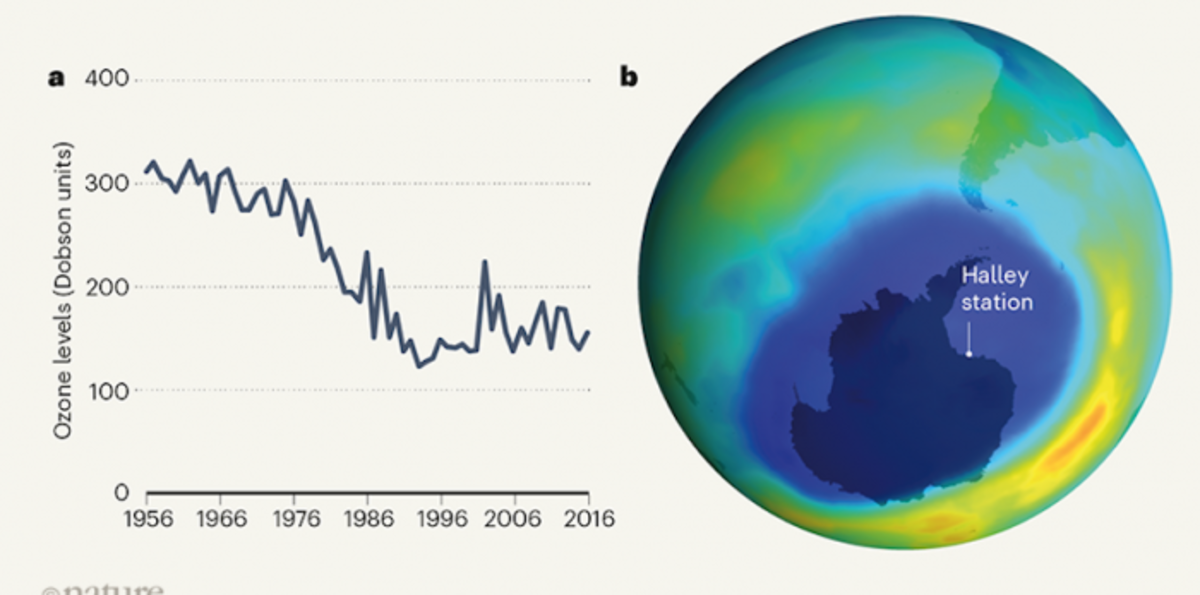PAOC Spotlights
The discovery of the Antarctic ozone hole

Read the full story at Nature
In the mid-1980s, scientists Joe Farman, Brian Gardiner and Jonathan Shanklin opened the world's eyes to a new phenomenon: "unanticipated and large decreases in stratospheric ozone levels over the Antarctic stations of Halley and Faraday," which became known as the Antarctic ozone hole, writes Susan Solomon, the EAPS Lee and Geraldine Martin Professor of Environmental Studies, in Nature. The seminal paper pointed to CFCs as the potential culprit and " transformed the fields of atmospheric science and chemical kinetics, and led to global changes in environmental policy."
Farman et al. seemingly became the paper that launched a thousand projects, including field studies in the polar regions, new atmospheric chemistry models, cloud chemistry and climate impacts, remote sensing, policy implementation, etc. "The careers of hundreds of scientists and dozens of diplomats worldwide were abruptly transformed by this single paper,"
The rigorous nature of the work, Solomon notes, likely played a role in initiating and promoting legislation to protect the ozone layer. While the stratospheric ozone hole is recovering and the Antarctic ozone hole is at it's smallest since it was discovered, the long lifetimes of CFCs (more than 50 years), mean that the atmoshere will not heal before 2050. The current production and release of CFC trichlorofluoromethane, however, is delaying that timeline.
The ozone hole and broader impacts for climate science and action
Dynamical studies have shown that the ozone hole influences Antarctic winds and temperatures not just in the stratosphere, but also in the underlying troposphere, and there is evidence for climate connections at other latitudes18. Modern global climate models therefore include increasingly detailed representations of stratospheric chemistry and dynamics. The ozone hole has thus inspired a new generation of scientists to probe climate–chemistry interactions, forging connections between previously separate disciplines.
Scientists' ability to jump on the problem and provide their findings, which supported the initial paper, to policymakers played a significant part in rolling out and ratifying global legislation to prevent the ozone layer from collapsing--making it a "signature success story for global environmental policy," Solomon notes.
However, recent work20 provides strong evidence of the continuing production and release of one type of CFC (trichlorofluoromethane). The source is not large enough to reverse the healing of the ozone hole, but it is slowing recovery and shows that there is still a need for scrutiny in this field. Research into, and policy to protect, the stratosphere will thus continue to be inspired by Farman and colleagues’ research — and will probably do so until the ozone hole finally closes.
Story Image: Ozone over Antarctica. a, In 1985, Farman et al.1 reported that stratospheric ozone levels over the Halley and Faraday stations in Antarctica during the austral spring had declined greatly from previously steady values. The graph shows the Halley times series, extended to 2016. b, Subsequent satellite monitoring revealed that the area of ozone depletion — the ozone hole — extended over a vast region. This map shows a satellite ozone map for 10 September 2000, when ozone depletion was close to its maximum: blue indicates low ozone levels; red, high levels. The position of the Halley station is indicated. (Credit: Nature)